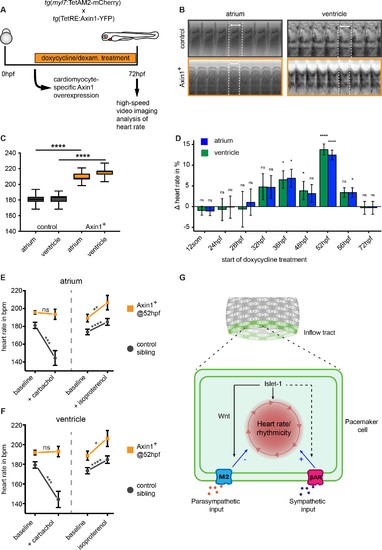Fig. 6
- ID
- ZDB-FIG-180611-91
- Publication
- Burkhard et al., 2018 - Spatially resolved RNA-sequencing of the embryonic heart identifies a role for Wnt/β-catenin signaling in autonomic control of heart rate
- Other Figures
- All Figure Page
- Back to All Figure Page
|
Wnt/β-catenin signaling regulates parasympathetic control of heart rate. (A) Experimental timeline. Embryos with the ubiquitous tg(TETRE:Mmu.Axin1-YFP)tud1 and cardiomyocyte-specific tg(myl7:TETAM2-2A-mCherry)ulm8 transgenes were incubated with doxycycline (25 μg/mL) plus dexamethasone (100 μM) to induce cardiomyocyte specific Axin1-YFP expression. Axin1-YFP was induced at different time points and the heart rate was measured at 3 dpf by high-speed video imaging and image analysis. (B) Atrial and corresponding ventricular kymographs from a representative mCherry-/YFP- sibling control and an embryo with Axin1-YFP overexpression (Axin1+). Note the shorter period per full heartbeat (indicated by white dotted lines) in the Axin1 expressing embryo. Movies are available as Figure 6—videos 1 and 2, respectively. (C) Result of heart rate analysis (ventricle and atrium) on sibling and Axin1+ embryos, showing a significant increase in heart rate in Axin1+ embryos. (D) Relative changes in heart rate measured at 3 dpf after induction of Axin1 expression at various time points. ∆heart rate was calculated by using the heart rates measured in the Axin1+ group and the control group using the following formula: (Axin1-YFP+ - mCherry-/YFP-) / (mCherry-/YFP-) x 100%. Induction of Axin1-YFP expression between 32 hpf and 56 hpf resulted in increased heart rates at 3 dpf. See also Figure 6—videos 1 and 2. n(control/Axin1+) 9/6 (12som); 20/15 (24hpf); 10/7 (28hpf); 18/16 (32hpf); 10/8 (36hpf); 30/21 (48hpf); 37/28 (52hpf); 27/23 (56hpf); 30/29 (72hpf). Column bar graph plotting mean with SEM. Atrial (green) and ventricular (blue) analysis (E–F) Heart rates at 3 dpf of control (mCherry-/YFP-) or Axin1-YFP+ embryos at baseline or after treatment with the parasympathetic agonist carbachol or the sympathetic agonist isoproterenol. Atrial (E) and ventricular (F) measurements. (left n = 27 (control), 26 (Axin+); right n = 20 (control), 14 (Axin+)) (G) Proposed model for Isl1/Wnt function in cardiac pacemaker cells. Isl1 is a central factor in pacemaker cell development. Isl1 expression is restricted to pacemaker cells in which it is required to establish the rhythmic cycle of membrane depolarizations and heart contractions and the activation of Wnt/β-catenin signaling. Wnt/β-catenin signaling is required to establish M2 cholinergic receptor signaling, which allows parasympathetic signals (e.g. acetylcholine) to adjust the rate of rhythmic membrane depolarizations and heart contractions. βAR, β-Adrenergic Receptor. Statistical significance (unpaired (D) and paired (E–F) t-test) *p<0.05; **p<0.01; ***p<0.001; ****p<0.0001. See also Figure 6—source data 1, Figure 6—figure supplement 1, Figure 6—figure supplement 2, Figure 6—figure supplement 3, Figure 6—video 1 and Figure 6—video 2. |

